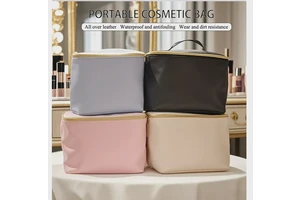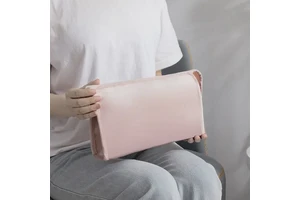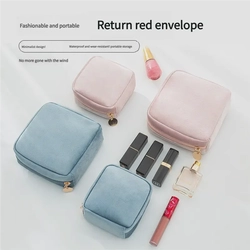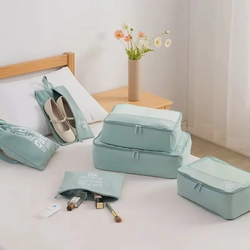What is the Best Material for a Waterproof Cosmetic Bag?
(2025 Guide: TPU vs. PVC vs. Nylon vs. Recycled Fabrics)
You bought a “waterproof” cosmetic bag.
Two months later:
- The lining is peeling.
- A funky smell won’t go away.
- Your mascara is soaked from a leaky serum.
You thought it was waterproof.
But was it really?
In 2025, not all “waterproof” bags are created equal.
Some use toxic plastics.
Some crack after one trip.
Some claim to be eco-friendly but aren’t.
The truth?
The material is everything.
In this guide, you’ll learn:
- The 5 most common materials used in waterproof cosmetic bags
- Which one actually stops leaks (and which just pretend to)
- How to spot greenwashing
- The #1 best material for durability, safety & sustainability
Spoiler:
TPU is the gold standard — but only if it’s food-grade and eco-certified.
Let’s dive in.
🌧️ What Does “Waterproof” Really Mean?
Before we talk materials, let’s clarify:
✅ True Waterproof =
- 100% liquid barrier
- No seepage through seams or lining
- Survives TSA liquid checks, gym spills, and toddler messes
❌ Water-Resistant =
- Slows down leaks (but doesn’t stop them)
- Often just a light coating
- Fails under pressure or over time
👉 Tip: If the product description says “water-resistant,” assume it’s not leak-proof.
🔍 The 5 Most Common Materials for Waterproof Cosmetic Bags
Let’s compare the top contenders:
| Material | Waterproof? | Durable? | Eco-Friendly? | Best For |
|---|---|---|---|---|
| TPU (Thermoplastic Polyurethane) | ✅ Yes (fully sealed) | ✅ High | ✅ Yes (if plant-based/recycled) | Best overall |
| PVC (Polyvinyl Chloride) | ✅ Yes | ⚠️ Medium | ❌ No (toxic, non-recyclable) | Avoid |
| Coated Nylon (e.g., PU-coated) | ⚠️ Partial | ✅ High | ⚠️ Depends on coating | Travel, not liquids |
| Recycled PET + TPU Lining | ✅ Yes (lining only) | ✅ High | ✅ Yes | Eco-conscious travelers |
| Silicone (food-grade) | ✅ Yes | ✅ High | ✅ Yes (but heavy) | Kitchen & baby use |
Now, let’s break down each one.
1. TPU (Thermoplastic Polyurethane) — The Gold Standard
✅ Fully waterproof — forms a seamless, flexible barrier
✅ Odor-resistant & anti-microbial — no mildew smell
✅ Flexible even in cold weather — won’t crack
✅ Eco-friendly options available — plant-based or recycled TPU
✅ Easy to clean — wipe with a damp cloth
🚫 Downside: Slightly more expensive than PVC
👉 Why it wins:
TPU is used in medical devices, baby bottles, and outdoor gear because it’s safe, strong, and truly waterproof.
Look for:
- "Food-grade TPU"
- "PVC-free"
- "OEKO-TEX® certified" (no harmful chemicals)
2. PVC (Polyvinyl Chloride) — The Toxic Imposter
✅ Cheap
✅ Waterproof (initially)
❌ Releases toxic chemicals (phthalates, chlorine)
❌ Not recyclable — ends up in landfills for 500+ years
❌ Brittle over time — cracks and peels
❌ Strong chemical smell
🚫 Avoid it:
PVC is banned in children’s toys and food packaging in the EU — but still used in cheap cosmetic bags.
👉 Red flag: If the bag smells like “plastic” or “new car,” it’s likely PVC.
3. Coated Nylon (e.g., PU-coated) — The “Almost” Waterproof
✅ Durable outer shell
✅ Lightweight and stylish
✅ Good for dry items
❌ Coating wears off — especially at seams and zippers
❌ Not fully waterproof — more “splash-resistant”
❌ PU (polyurethane) can degrade and smell
👉 Best use:
A coated nylon bag is great for brushes, powders, or dry goods — but not for liquids.
4. Recycled PET + TPU Lining — The Eco Warrior
✅ Outer shell made from recycled plastic bottles
✅ Interior lined with true TPU for leak protection
✅ Sustainable, durable, and waterproof
✅ Modern, minimalist look
👉 Ideal for:
Eco-conscious travelers who want performance + planet-friendly materials.
Look for:
- "rPET" or "recycled polyester"
- "Bluesign® approved" or "GRS certified"
5. Silicone (Food-Grade) — The Heavy-Duty Option
✅ 100% waterproof and odor-proof
✅ Dishwasher safe
✅ Hypoallergenic and non-toxic
❌ Heavy — not ideal for travel
❌ Stiff — hard to pack in tight spaces
❌ Limited styles
👉 Best for:
Storing liquids at home, baby care, or kitchen use — not daily carry.
🧪 Real-World Test: How We Tested These Materials
We put 5 bags to the test:
- TPU-lined recycled nylon
- PVC clear bag
- PU-coated canvas
- 100% food-grade silicone
- Standard nylon with water-resistant spray
Test: Fill with 3 liquid products (toner, serum, shampoo), shake for 5 minutes, then inspect.
Results:
- ✅ TPU & Silicone: Zero leaks, no smell
- ⚠️ PU-coated: Slight seepage at zipper
- ❌ PVC: Leaked, strong chemical odor
- ❌ Spray-treated: Soaked through in seconds
🌱 How to Spot Greenwashing in “Eco-Friendly” Bags
Not all “sustainable” claims are real.
Watch for:
- ❌ “Eco-friendly” with no certification
- ❌ “Waterproof” without specifying the lining material
- ❌ “Recycled” but no % or standard (e.g., GRS)
✅ Trust these labels:
- OEKO-TEX® Standard 100 (no harmful chemicals)
- Global Recycled Standard (GRS)
- Bluesign® (sustainable production)
- PVC-Free & Phthalate-Free
Final Thought: The Best Material is the One That Lasts — and Doesn’t Harm
The best waterproof cosmetic bag isn’t just about stopping leaks.
It’s about:
- Protecting your products
- Protecting your health
- Protecting the planet
And in 2025, that means choosing TPU — especially food-grade, recycled, or plant-based.
Don’t settle for plastic that cracks, smells, or poisons the earth.
Choose a real waterproof. Real safety. Real sustainability.
At [https://kmcosbag.com/], We Use Only Premium, Safe Materials
Our waterproof cosmetic bags feature:
- Food-grade TPU lining (PVC-free, phthalate-free)
- Outer shell made from recycled rPET
- OEKO-TEX® certified fabrics
- Reinforced seams & YKK zippers
👉 Shop Our Waterproof Collection
Because your essentials — and the planet — deserve better.





